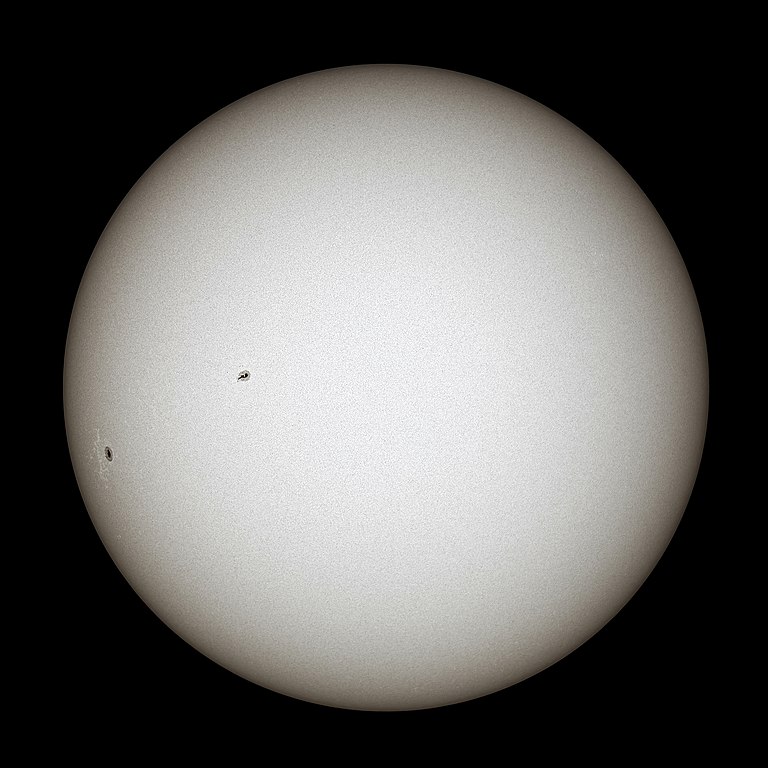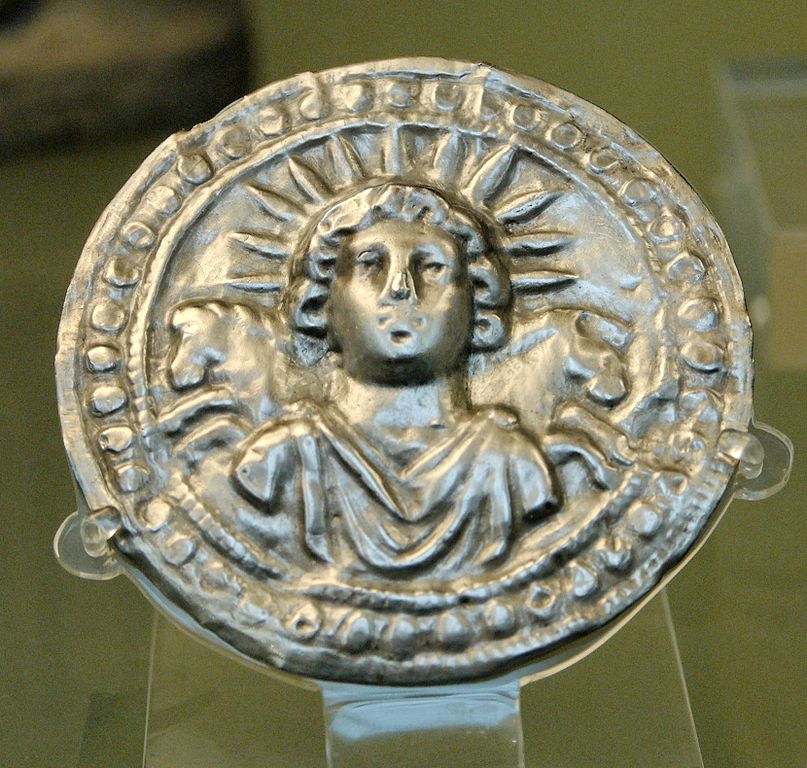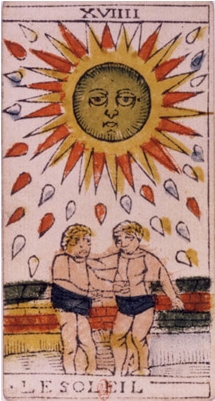Difference between revisions of "Sun"
Occultwiki (talk | contribs) |
Occultwiki (talk | contribs) |
||
| (6 intermediate revisions by the same user not shown) | |||
| Line 14: | Line 14: | ||
The Sun has been an object of veneration in many cultures throughout human history. Humanity's most fundamental understanding of the Sun is as the luminous disk in the sky, whose presence above the horizon causes day and whose absence causes night. In many prehistoric and ancient cultures, the Sun was thought to be a solar deity or other supernatural entity. The Sun has played an important part in many world religions, as described in a later section. | The Sun has been an object of veneration in many cultures throughout human history. Humanity's most fundamental understanding of the Sun is as the luminous disk in the sky, whose presence above the horizon causes day and whose absence causes night. In many prehistoric and ancient cultures, the Sun was thought to be a solar deity or other supernatural entity. The Sun has played an important part in many world religions, as described in a later section. | ||
In the early first millennium BC, Babylonian astronomers observed that the Sun's motion along the ecliptic is not uniform, though they did not know why; it is today known that this is due to the movement of Earth in an elliptic orbit around the Sun, with Earth moving faster when it is nearer to the Sun at perihelion and moving slower when it is farther away at aphelion. | In the early first millennium BC, Babylonian astronomers observed that the Sun's motion along the ecliptic is not uniform, though they did not know why; it is today known that this is due to the movement of Earth in an elliptic orbit around the Sun, with Earth moving faster when it is nearer to the Sun at [[perihelion]] and moving slower when it is farther away at aphelion. | ||
One of the first people to offer a scientific or philosophical explanation for the Sun was the Greek philosopher Anaxagoras. He reasoned that it was not the chariot of Helios, but instead a giant flaming ball of metal even larger than the land of the Peloponnesus and that the Moon reflected the light of the Sun. For teaching this [[heresy]], he was imprisoned by the authorities and sentenced to death, though he was later released. | One of the first people to offer a scientific or philosophical explanation for the Sun was the Greek philosopher Anaxagoras. He reasoned that it was not the chariot of Helios, but instead a giant flaming ball of metal even larger than the land of the Peloponnesus and that the [[Moon]] reflected the light of the Sun. For teaching this [[heresy]], he was imprisoned by the authorities and sentenced to death, though he was later released. | ||
The theory that the Sun is the center around which the planets orbit was first proposed by the ancient Greek Aristarchus of Samos in the third century BC, and later adopted by Seleucus of Seleucia. This view was developed in a more detailed mathematical model of a heliocentric system in the 16th century by [[Nicolaus Copernicus]]. | The theory that the Sun is the center around which the planets orbit was first proposed by the ancient Greek Aristarchus of Samos in the third century BC, and later adopted by Seleucus of Seleucia. This view was developed in a more detailed mathematical model of a heliocentric system in the 16th century by [[Nicolaus Copernicus]]. | ||
The invention of the telescope in the early 17th century permitted detailed observations of sunspots by Thomas Harriot, [[Galileo Galilei]] and other astronomers. Galileo posited that sunspots were on the surface of the Sun rather than small objects passing between [[Earth]] and the Sun. | The invention of the telescope in the early 17th century permitted detailed observations of sunspots by Thomas Harriot, [[Galileo Galilei]] and other astronomers. Galileo posited that sunspots were on the surface of the Sun rather than small objects passing between [[Earth]] and the Sun. | ||
The movement of the earth around the sun is the basis of the [[Gregorian calendar]]. | |||
==Solar Religion== | ==Solar Religion== | ||
| Line 26: | Line 28: | ||
Solar deities play a major role in many world religions and mythologies. Worship of the Sun was central to civilizations such as the [[Egyptian religion|ancient Egyptians]], the Inca of South America and the Aztecs of what is now Mexico. In religions such as [[Hinduism]], the Sun is still considered a god, he is known as Surya Dev. Many ancient monuments were constructed with solar phenomena in mind; for example, stone megaliths accurately mark the summer or [[winter solstice]]; Newgrange, a prehistoric human-built mount in Ireland, was designed to detect the winter solstice; the pyramid of El Castillo at Chichén Itzá in Mexico is designed to cast shadows in the shape of serpents climbing the pyramid at the vernal and autumnal equinoxes. | Solar deities play a major role in many world religions and mythologies. Worship of the Sun was central to civilizations such as the [[Egyptian religion|ancient Egyptians]], the Inca of South America and the Aztecs of what is now Mexico. In religions such as [[Hinduism]], the Sun is still considered a god, he is known as Surya Dev. Many ancient monuments were constructed with solar phenomena in mind; for example, stone megaliths accurately mark the summer or [[winter solstice]]; Newgrange, a prehistoric human-built mount in Ireland, was designed to detect the winter solstice; the pyramid of El Castillo at Chichén Itzá in Mexico is designed to cast shadows in the shape of serpents climbing the pyramid at the vernal and autumnal equinoxes. | ||
The ancient Sumerians believed that the Sun was Utu, the god of justice and twin brother of Inanna, the Queen of Heaven, who was identified as the planet [[Venus]]. Later, Utu was identified with the East Semitic god Shamash. Utu was regarded as a helper-deity, who aided those in distress, and, in iconography, he is usually portrayed with a long beard and clutching a saw, which represented his role as the dispenser of justice. | The ancient Sumerians believed that the Sun was Utu, the god of justice and twin brother of Inanna, the Queen of [[Heaven]], who was identified as the planet [[Venus]]. Later, Utu was identified with the East Semitic god Shamash. Utu was regarded as a helper-deity, who aided those in distress, and, in iconography, he is usually portrayed with a long beard and clutching a saw, which represented his role as the dispenser of justice. | ||
===Egypt=== | ===Egypt=== | ||
| Line 35: | Line 37: | ||
==Abrahamic religions== | ==Abrahamic religions== | ||
In the [[Bible]], Malachi 4:2 mentions the "Sun of Righteousness" (sometimes translated as the "Sun of Justice"), which some [[Christianity|Christians]] have interpreted as a reference to [[Jesus Christ]]. In ancient Roman culture, Sunday was the day of the sun god. It was adopted as the | In the [[Bible]], Malachi 4:2 mentions the "Sun of Righteousness" (sometimes translated as the "Sun of Justice"), which some [[Christianity|Christians]] have interpreted as a reference to [[Jesus Christ]]. In ancient Roman culture, Sunday was the day of the sun god. It was adopted as the [[Sabbat]]h day by Christians who did not have a [[Judaism|Jewish]] background. The symbol of light was a [[pagan]] device adopted by Christians, and perhaps the most important one that did not come from Jewish traditions. | ||
In [[Kabbalah]], the sun rules over the [[sefirot]] of [[Tiferet]] and its opposing [[qlippoth]] [[Thagiriron]]. | |||
==Astrology== | ==Astrology== | ||
[[File:The Sun Marseilles.jpg|350px|thumb|The Sun card from the [[Tarot of Marseilles]]]] | [[File:The Sun Marseilles.jpg|350px|thumb|[[The Sun]] card from the [[Tarot of Marseilles]]]] | ||
Sun sign [[astrology]], or star sign astrology, is a modern simplified system of Western astrology which considers only the position of the Sun at birth, which is said to be placed within one of the twelve [[zodiac]] signs, rather than the positions of the sun and the other six planets. This sign is then called the sun sign or star sign of the person born in that twelfth-part of the year. | Sun sign [[astrology]], or star sign astrology, is a modern simplified system of Western astrology which considers only the position of the Sun at birth, which is said to be placed within one of the twelve [[zodiac]] signs, rather than the positions of the sun and the other six planets. This sign is then called the sun sign or star sign of the person born in that twelfth-part of the year. | ||
Sun sign astrologers take this basic twelve-fold division and relate all the current movements of all the planets to each other, using traditional rules to divine meanings for each sign separately. Because the [[Moon]] has the fastest apparent movement of all the heavenly bodies, it is often used as the main indicator of daily trends for sun sign astrology forecasts. | Sun sign astrologers take this basic twelve-fold division and relate all the current movements of all the planets to each other, using traditional rules to divine meanings for each sign separately. Because the [[Moon]] has the fastest apparent movement of all the heavenly bodies, it is often used as the main indicator of daily trends for sun sign astrology forecasts. | ||
===Spiritual rulers=== | |||
* The [[Olympic spirit]] [[Och]]. | |||
* The [[Planetary intelligence]] [[Nachiel]]. | |||
* The [[Planetary spirit]] [[Sorath]]. | |||
[[Category:Astrology]] | [[Category:Astrology]] | ||
Latest revision as of 16:32, 11 February 2025
The Sun is the star at the center of the Solar System. It is a nearly perfect ball of hot plasma, heated to incandescence by nuclear fusion reactions in its core. The Sun radiates this energy mainly as light, ultraviolet, and infrared radiation, and is the most important source of energy for life on Earth.
It formed approximately 4.6 billion years ago from the gravitational collapse of matter within a region of a large molecular cloud.
Characteristics
The Sun is a G-type main-sequence star that constitutes about 99.86% of the mass of the Solar System. The Sun has an absolute magnitude of +4.83, estimated to be brighter than about 85% of the stars in the Milky Way, most of which are red dwarfs.
The Sun's radius is about 695,000 kilometers (432,000 miles), or 109 times that of Earth. Its mass is about 330,000 times that of Earth, comprising about 99.86% of the total mass of the Solar System. Roughly three-quarters of the Sun's mass consists of hydrogen (~73%); the rest is mostly helium (~25%), with much smaller quantities of heavier elements, including oxygen, carbon, neon, and iron.
The Sun lies about 26,660 light-years from the Galactic Center, and its speed around the center of the Milky Way is about 220 km/s, so that it completes one revolution every 240 million years. This revolution is known as the Solar System's galactic year. Some scientists have theorized that the Sun rotates around the star Sirius every 25,000 years.
Human observation
The Sun has been an object of veneration in many cultures throughout human history. Humanity's most fundamental understanding of the Sun is as the luminous disk in the sky, whose presence above the horizon causes day and whose absence causes night. In many prehistoric and ancient cultures, the Sun was thought to be a solar deity or other supernatural entity. The Sun has played an important part in many world religions, as described in a later section.
In the early first millennium BC, Babylonian astronomers observed that the Sun's motion along the ecliptic is not uniform, though they did not know why; it is today known that this is due to the movement of Earth in an elliptic orbit around the Sun, with Earth moving faster when it is nearer to the Sun at perihelion and moving slower when it is farther away at aphelion.
One of the first people to offer a scientific or philosophical explanation for the Sun was the Greek philosopher Anaxagoras. He reasoned that it was not the chariot of Helios, but instead a giant flaming ball of metal even larger than the land of the Peloponnesus and that the Moon reflected the light of the Sun. For teaching this heresy, he was imprisoned by the authorities and sentenced to death, though he was later released.
The theory that the Sun is the center around which the planets orbit was first proposed by the ancient Greek Aristarchus of Samos in the third century BC, and later adopted by Seleucus of Seleucia. This view was developed in a more detailed mathematical model of a heliocentric system in the 16th century by Nicolaus Copernicus.
The invention of the telescope in the early 17th century permitted detailed observations of sunspots by Thomas Harriot, Galileo Galilei and other astronomers. Galileo posited that sunspots were on the surface of the Sun rather than small objects passing between Earth and the Sun.
The movement of the earth around the sun is the basis of the Gregorian calendar.
Solar Religion
Solar deities play a major role in many world religions and mythologies. Worship of the Sun was central to civilizations such as the ancient Egyptians, the Inca of South America and the Aztecs of what is now Mexico. In religions such as Hinduism, the Sun is still considered a god, he is known as Surya Dev. Many ancient monuments were constructed with solar phenomena in mind; for example, stone megaliths accurately mark the summer or winter solstice; Newgrange, a prehistoric human-built mount in Ireland, was designed to detect the winter solstice; the pyramid of El Castillo at Chichén Itzá in Mexico is designed to cast shadows in the shape of serpents climbing the pyramid at the vernal and autumnal equinoxes.
The ancient Sumerians believed that the Sun was Utu, the god of justice and twin brother of Inanna, the Queen of Heaven, who was identified as the planet Venus. Later, Utu was identified with the East Semitic god Shamash. Utu was regarded as a helper-deity, who aided those in distress, and, in iconography, he is usually portrayed with a long beard and clutching a saw, which represented his role as the dispenser of justice.
Egypt
From at least the Fourth Dynasty of Ancient Egypt, the Sun was worshipped as the god Ra, portrayed as a falcon-headed divinity surmounted by the solar disk, and surrounded by a serpent. In the New Kingdom period, the Sun became identified with the dung beetle, whose spherical ball of dung was identified with the Sun. In the form of the sun disc Aten, the Sun had a brief resurgence during the Amarna Period when it again became the preeminent, if not only, divinity for the Pharaoh Akhenaton. The Egyptians portrayed the god Ra as being carried across the sky in a solar barque, accompanied by other gods, including the Egyptian decans.
Greece
From the reign of Elagabalus in the late Roman Empire the Sun's birthday was a holiday celebrated as Sol Invictus (literally "Unconquered Sun") soon after the winter solstice, which may have been an antecedent to Christmas. Regarding the fixed stars, the Sun appears from Earth to revolve once a year along the ecliptic through the zodiac, and so Greek astronomers categorized it as one of the seven planets (Greek planetes, "wanderer"); the naming of the days of the weeks after the seven planets dates to the Roman era.
Abrahamic religions
In the Bible, Malachi 4:2 mentions the "Sun of Righteousness" (sometimes translated as the "Sun of Justice"), which some Christians have interpreted as a reference to Jesus Christ. In ancient Roman culture, Sunday was the day of the sun god. It was adopted as the Sabbath day by Christians who did not have a Jewish background. The symbol of light was a pagan device adopted by Christians, and perhaps the most important one that did not come from Jewish traditions.
In Kabbalah, the sun rules over the sefirot of Tiferet and its opposing qlippoth Thagiriron.
Astrology
Sun sign astrology, or star sign astrology, is a modern simplified system of Western astrology which considers only the position of the Sun at birth, which is said to be placed within one of the twelve zodiac signs, rather than the positions of the sun and the other six planets. This sign is then called the sun sign or star sign of the person born in that twelfth-part of the year.
Sun sign astrologers take this basic twelve-fold division and relate all the current movements of all the planets to each other, using traditional rules to divine meanings for each sign separately. Because the Moon has the fastest apparent movement of all the heavenly bodies, it is often used as the main indicator of daily trends for sun sign astrology forecasts.
Spiritual rulers
- The Olympic spirit Och.
- The Planetary intelligence Nachiel.
- The Planetary spirit Sorath.


